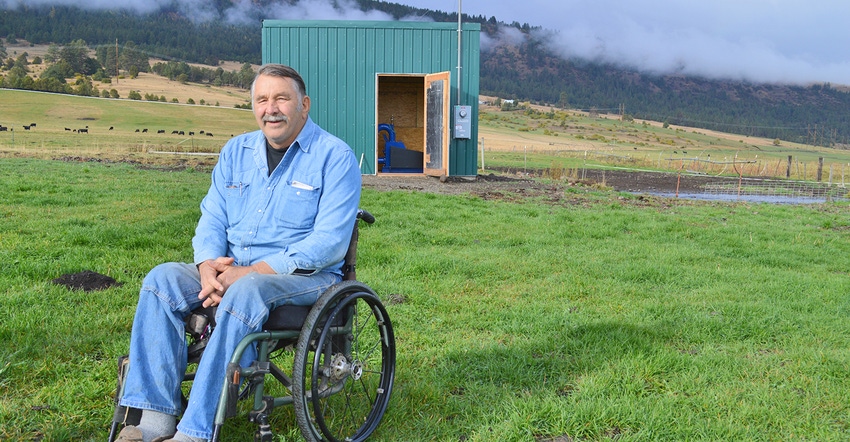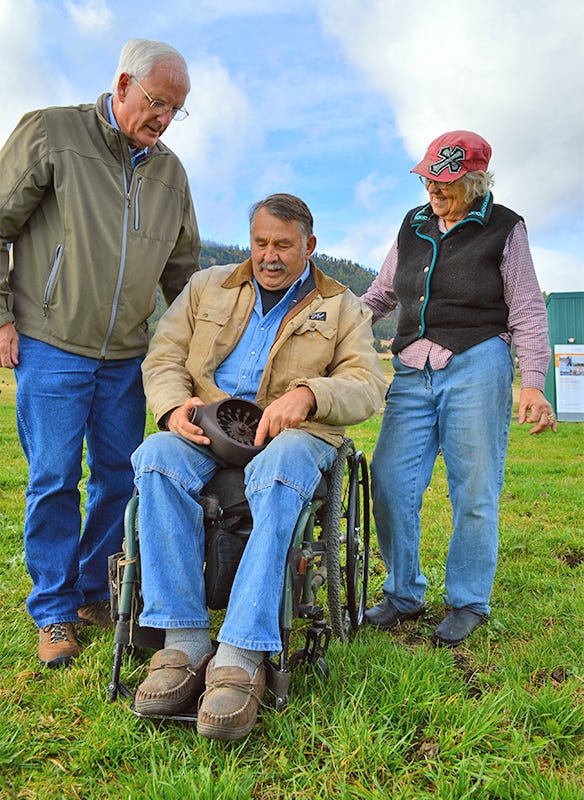April 30, 2018

Editor’s note: This is the sixth story in a series exploring how ranchers and farmers are benefiting from renewable energy.
Ag producer Vern Spaur loves repairing old farm equipment, restoring jalopies and overhauling motors.
One day while working on a century-old Pelton hydro wheel, he gazed at the beautiful mountains above his family’s ranch, near the Oregon-Washington-Idaho border, and got to thinking.

SHOW AND TELL: Oregon state Sen. Bill Hansell (left) was among those attending a ribbon-cutting hosted by Vern and Marti Spaur, who have installed two 11-kilowatt hydroelectric projects on their family ranch. Spaur holds an antique Pelton turbine in his lap — the same technology, little changed, that produces power for the ranch and commercial vehicle repair shop.

Why not put this turbine and the water coming down that steep irrigation ditch to work generating electricity?
Spaur’s go-getter attitude went into high gear. After finishing repairs on the wheel, he joined forces with family members and helpers to build a one-half-mile pipeline down the mountainside. They also constructed a small hydropower facility using that same antique Pelton.
Soon, water began roaring down the 10-inch pipe, picking up enough pressure in 80 vertical feet of drop to power the irrigation system and generate about 11 kilowatts of electricity.
“That was my first venture into Pelton wheels, and the hydropower project was working so well for us we decided to put in another 11-kilowatt hydro system,” Spaur says. “I like the fact that things like hydro and solar leave a very light environmental footprint. Installing systems like these just boil down to whether they’ll make a profit or not.”
He continues, with a smile: “In our case, these two systems are saving us about $10,000 to $12,000 per year in electrical costs. The only thing I’ve ever done is, once a month I grease the bearings in the generators and the Pelton wheels.”

BACK TO THE FUTURE: Agricultural producer Vern Spaur, a collector of vintage machines, holds a century-old Pelton wheel turbine. He shows it to people who tour the hydroelectric facilities on his family’s ranch, near the Oregon-Washington-Idaho border. It’s the same technology that now powers the two 11-kilowatt hydro plants on the ranch.

And though Spaur could have kept that old Pelton running, he decided to replace it with a modern Pelton turbine manufactured by Canyon Hydro in Deming, Wash.
“The Pelton wheel was invented back in the 1870s, and the hydro turbines being built today are basically using the same design principles,” Spaur says. “I find that truly amazing.”
The 76-year-old Spaur says that he and his family are doing everything they can to make the small ranching operation sustainable, and renewable energy has become part of the mix. The two hydro facilities generate enough electricity to power three homes, a commercial auto repair business and several outbuildings on the Spaur Ranch in Wallowa County, Ore.
“I like to take advantage of resources that don’t have a detrimental effect on anything, including the environment,” he notes. “Hydroelectricity is absolutely non-invasive, non-consumptive. We’re not taking anything away from anyone.”
Maximizing water rights
When Spaur’s family purchased the ranch in 1986, it came with water rights dating back to the late 1800s, when the man who homesteaded the place built a 7-mile-long irrigation ditch from the Lostine River.
“Nothing in our country is flat. Everything is on an incline,” Spaur says. “And on that day, I was working on the Pelton and looking at the mountains. I remember thinking, ‘Wow, why don’t we harness the energy coming down that ditch?’”
In addition to the two hydro plants, water builds up enough pressure in the pipeline to power the wheel lines via gravity flow. The irrigation systems provide water for 160 acres of hay ground, and the family also runs about 200 yearlings.
“That’s not enough to support two families, so over the years we leased up another 160 acres of irrigated lands for hay, and we also started repairing vehicles and farm machinery to help make ends meet,” Spaur says. “We have people bringing us pickups and other vehicles from all over the Pacific Northwest, and that developed into seven full-time employees on the ranch.”
Some of those employees also helped install the two small-scale hydro projects.
The pipeline is buried about 3 feet, and both plants run at 40 psi, which is low pressure for a hydro system. It’s still enough pressure, however, for the two 11-kilowatt Pelton turbines to generate 160,000 kilowatt-hours of electricity annually.
The systems together cost a total of about $250,000, and financial assistance and technical support made both projects feasible.
“Since we received help to build the hydro facilities, any electricity that we generate over and above our usage goes to charity,” Spaur says. “There are definitely many good opportunities for ranchers and farmers to develop renewable energy projects. If you do things right, you can have pretty inexpensive power.”
Renewable energy gaining steam
Many organizations and states across the country are providing incentives to help citizens, including ranchers and farmers, install renewable energy projects.
Spaur says that without financial help and technical support, it wouldn’t have been economically feasible to install the two small hydro facilities on his family’s ranch.

Jed Jorgensen

“We could make this work because of the low maintenance costs associated with hydro and the help we received,” Spaur says. “We fronted the money for the projects, and then, over a period of time, it was all returned to us through grant funds and tax credits.”
Among those providing assistance were Energy Trust of Oregon, Wallowa Resources Community Solutions Inc. and USDA Rural Energy for America Program.
“The situation with the Spaur Ranch is not too uncommon with many ranches in Oregon, Washington and Idaho,” says Jed Jorgensen, senior renewable energy program manager for Energy Trust of Oregon. “There are a lot of irrigation ditches and canals that run along hillsides in the region, and the farms and ranches are down below. Because of that, small hydro power facilities often make sense.”
Jorgensen says interest in developing small-scale hydro projects is increasing in the Pacific Northwest, in part because of projects like the ones on the Spaur Ranch.
“Those two hydro projects have certainly driven a lot of interest in the area,” Jorgensen says. “We’re looking at an application right now for a[nother] similar project in Wallowa County, Ore. There are a number of ditch companies in the county, and they are expressing a desire to modernize their systems.”
Spaur and his family often host tours to their ranch. A wide audience — including students ranging from elementary school to college — tours the hydro facilities, related irrigation systems and farm ground.
“Over the years we’ve hosted hundreds of people, and everyone seems very interested in learning about generating power from water,” Spaur says.
“A number of our neighbors now have solar operations, including some on ranches and farms, and I’ve been told by some of the locals that there are a number of hydro projects in the works on agricultural operations,” Spaur says.
Rancher an inspiration for people with disabilities
Spaur has gained the admiration and respect of many people for his work ethic, ingenuity and positive attitude — three things that have constantly followed him through life since suffering severe injuries during a logging accident in 1985.
Working as a professional logger at the time, Spaur was in the process of felling a tree when a snag “tried to drive me into the ground.” He suffered 17 factures in his spinal column, which left him partially paralyzed.
“We always dreamed of retiring in Wallowa County. It’s very beautiful country up here,” Spaur says. “The accident encouraged me and my wife, Marti, and our children to move here a lot earlier than we had planned.”
They purchased a small ranch, began growing hay and raising cattle, and then started a vehicle repair business to help make ends meet.
Now, the word “retirement” is no longer in the vocabulary of the 76-year-old Spaur. “I stay as busy as I can on the ranch, helping where I can. We modified tractors so I could still work, and we put in some gated pipe for irrigation after I figured out that moving gated pipe is not nearly as strenuous as moving wheel lines.”
Spaur says that he wasn’t about to let his physical handicap interfere with his dream to install a hydroelectric project.
“My son, Vern Jr., and I put in the systems with the help of others,” Spaur says. “I dug the trench for the pipeline with a backhoe I modified, we put in the hydro plant with help, and a couple of guys from our shop assisted us in laying one-half-mile of pipeline.”
“The two hydro projects could not have been accomplished without the support of Marti, my wife of 58 years; my daughter and son-in-law, Cindy and Leonard Post; my grandchildren and many others,” he adds.
All that hard work involving family, employees and others now pays off every time Spaur hosts people to his ranch to learn about the hydro facilities.
“While holding an old Pelton hydro wheel in my lap, I love to visit about the theory behind the wheel and how it’s now helping ranchers, farmers and many others generate their own electricity,” Spaur says. “That old antique is a great show-and-tell piece.”
Waggener writes from Laramie, Wyo.
About the Author(s)
You May Also Like




